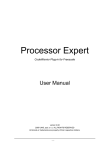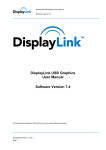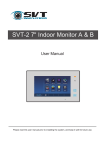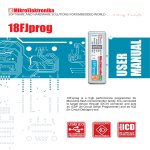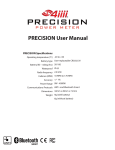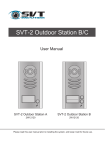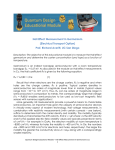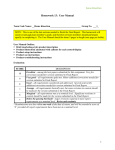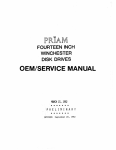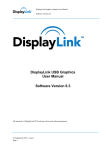Download iP 15 Series Manual
Transcript
(Quickstart Section is on Page 2.) OWNER’S MANUAL iP 15 Series WEB CONTROLLED AC POWER DISTRIBUTION 8/15 INTRODUCTION iP 15 Series WEB BASED REMOTE POWER CONTROL The Juice Goose iP1515 and iP1520 are microcontroller based power distribution devices that can be accessed via Internet or intranet communications using Ethernet or RS232 connection. With this remote access, individual AC receptacles can be turned on and off and AC power receptacles can be monitored for electrical current flow. The iP1515 has a 15 amp capacity. The iP1520 has a 20 amp capacity. Both provide AC line conditioning and surge protection. SAFETY PRECAUTIONS The iP15 Series products are designed to operate at 120 volts, 60 hertz. Operation with any voltage or frequency other than that can damage the equipment and create an unsafe situation. CAUTION #1: These devices must be grounded. If a power extension cord is required, use a properly insulated and grounded cord. Failure to ground the device could expose the user to dangerous electric shock. CAUTION #2: These devices should be installed only by qualified electrical technicians using appropriate mounting hardware and correct installation techniques. Before installing make sure main power is off. CAUTION #3: Do not expose these products to moisture or salty air. Doing so could cause significant damage and create an unsafe condition. DISCLAIMER Juice Goose shall under no circumstances be held responsible for any losses, damage, or injury resulting directly or indirectly from the use of the iP15 device in a manner contrary to accepted safe operating methods or any instructions contained in this document. The user should determine prior to use whether this product is adequate, suitable and safe for the application intended. Since individual applications can be subject to extreme variation Juice Goose makes no representation or guarantee as to the suitability of the iP1515 or the iP1520 for any generally described application. Page 1 QUICKSTART GUIDE 1. Unbox the unit. The box should contain: iP15 Series device, Quick Start Guide, warranty card and Juice Goose promotional material. You will need a CAT5 network cable if attaching to a router, a CAT 5/6 crossover cable if connecting directly to a PC and a custom RS232 cable if you wish do connect via RS232 (see page 13 for a diagram on how to build the RS232 cable). 2. With your PC on and booted up, connect the iP15 to your router or PC using a suitable cable. If the iP15 is connected to a network router use a standard CAT 5 cable, if connected directly to a PC use a CAT 5/6 crossover cable. 3. Plug the iP15 power cord into a live AC receptacle, such as a wall outlet, with a twenty amp capacity (i.e. NEMA 5-20R). 4. The iP15 will take about 30 seconds to boot up and configure itself at which point the Network light on the front of the unit will illuminate, indicating network connectivity. If the Network light blinks or does not light at all check the cable connections. 5. Open up your web browser and type in the following default IP address to access the iP15: http://juicegoose. 6. At this point you will be prompted to log into the iP15. Initial login will be: Username: admin Password: juicegoose 7. You will be presented with the control section where you can control the iP15 PODS by clicking on the buttons or using the Sequence field by entering the value in seconds and clicking the Sequence UP button. 8. To setup a specific IP address, change passwords for the admin/user account or configure other advanced features of the iP device click on the iP Series Management link at the top right of the displayed page. You will need to be logged in as admin to access this section. This section is described in more detail beginning on page 6. See your system administrator, if you have one, for help with configuration. Page 2 DETAIL SPECIFICATIONS CHASSIS…………………………………………………………..………………...16 Gauge Steel DIMENSIONS (inches)……………………………………..….....………...1.72H x 19.0W x 7.0D WEIGHT (lbs)……………………………………………………………………………………..10.0 CIRCUIT BREAKER.........................…..…15A (iP1515) or 20A (iP1520) back panel, thermal POWER INPUT CORD..…….....7 Foot, SJTW with NEMA 5/15P (iP1515) or 5/20P (iP1520) (Note: iP1520 requires a NEMA 5/20R receptacle) VOLTAGE INPUT.……….....…………………………………………………...120 VAC at 60 Hz POWER OUTPUTS iP1515.....................Six NEMA 5/15R (controlled), one NEMA 5/15R (unswitched) iP1520.....................Six NEMA 5/20R (controlled), one NEMA 5/20R (unswitched) NUMBER OF CONTROLLABLE PODS……………………………………………………..Three RELAY CURRENT RATING (amps).....................................……………………………........30 POWER LINE FILTRATION...………………………………Multi-stage Filter (48dB at 30 MHz) MICROCONTROLLER………………………………………..…...……..Microchip PIC18F97J60 COMMUNICATIONS LINES Ethernet (Network)………….......................................................……RJ-45 (8 Wire) RS232................................................................................................RJ-11 (3 Wire) COMMUNICATIONS PROTOCOL..................................................HTML, TCP, UDP, RS232 MONTIOR FEATURES Front Panel.............................................Power On and Network Connection LEDs Web Based.......................................Outlet On, Sequence Delay and Current Flow ( Additional web based control features are described in this Manual.) OPERATING TEMPERATURE RANGE (degrees Fahrenheit) Operating....................................................................................................32 to 158 Storage......................................................................................................-40 to 185 FRONT PANEL FEATURES ROCKER SWITCH - The primary intent is for the iP15 to be controlled via a remote RS232 or Ethernet link. This switch serves as a fail safe control device in the event a remote RS232 or Ethernet connection is not available or functioning. Moving this switch to the UP position will cause the iP15 to turn on the three power PODs in a prescribed timed sequence. The default timing is two seconds between each POD activation. This timing can be changed by accessing the on board web server. Moving this switch to the DOWN position will cause the unit to turn off the POD outlets in the reverse order. RECESSED SLIDE SWITCH - As a second fail safe control point, this switch can be used to manually turn on all POD outlets in the unlikely event of failure of the control circuitry contained in the iP15. This switch will turn on all POD outlets simultaneously. When the switch is returned to it’s “off” position the iP15 will revert to the prior state the unit was in. NETWORK LED - This LED will light up solid when the iP15 is connected to an Page 3 Ethernet network connection. It will blink quickly when an Ethernet cable is attached but no network can be found. When no network cable is connected or when using RS232 the light will blink slowly indicating the unit is powered up. POD LEDs - As each of the POD duplex receptacles on the back of the iP15 turns on a corresponding LED on the front of the unit will light. Each LED will turn off when the POD turns off. BACK PANEL FEATURES NETWORK (Ethernet) PORT - This RJ45 connector is for connecting to your PC, router or local area network using a TCP/IP link. RS232 PORT- This RJ11 connector can be used for remote control of the iP15 via RS232 protocol over distances not to exceed 50 feet. PODs 1 -3 - There are three duplex receptacles on the back of the iP15. Each is rated for a maximum twenty amp load and each is controllable to turn on or off independently of the others. When the on board sequencing process is used POD 1 will turn on first, followed in order by POD 2 and POD 3. They will turn of in reverse order using this same process. UNSWITCHED OUTLET - This single outlet is rated for a maximum load of fifteen amps on the iP1515 and twenty amps on the iP1520. It will have power any time the iP device is plugged into a live AC receptacle. Page 4 DETAILED INSTALLATION AND SETUP Unbox the unit. The box contains: the iP15 unit, the iP15 manual and a warranty card . Mount the iP15 in a 19” wide rack with metal mounting rails, designed with 1.75” spacing. Use appropriate rack mounting hardware. Always power the IP15 on a grounded outlet. Do not defeat the grounding feature of the iP15 power cord. SET UP DETAIL Connecting to the iP15 using a Router. 1. Connect the iP15 to your network router using a Cat 5 cable plugged into the RJ45 “Network” port on the rear of the unit and the other end to your network router. 2. Plug the iP15 power cord into a live AC receptacle, such as a wall outlet. Note: The iP1520 requires a 20 amp, NEMA 5-20R receptacle. 3. The iP15 will take a few seconds to boot up and configure itself at which point the Network light on the front of the unit should illuminate and remain on without blinking, indicating network connectivity. If the Network light blinks check the cable connections. 4. Open a web browser on your PC and type in the following address on the navigation bar to access the iP15: http://juicegoose Be sure to type exactly as shown. No domain such as .com should be added: 5. You will be presented with the login box. Enter the following initial username and password (these can be changed later): User: admin Password: juicegoose Connecting to the iP15 using a Crossover CAT5/6 cable. (recommended for advanced users only) To connect the iP15 to a PC directly you will need to change the properties of your internet connection/IP address. 1. Plug the CROSSOVER cable into the PC network socket and the other end into the iP15 Network socket . 2. Plug the iP device power cord into a live AC receptacle, such as a wall outlet. Note: the iP1520 power cord requires a twenty amp, NEMA 5-20R, receptacle. 3. The iP15 device will take a few seconds to boot up and configure itself at Page 5 which point the Network light on the front of the unit should illuminate and remain on without blinking, indicating network connectivity. If the Network light blinks check the cable connections. 4. In Windows go to your start menu and navigate to the control panel. Then choose the Network Connections” icon. 5. Open Network connections by double clicking on it, select the LAN or HIGHSPEED icon, right click on this and select properties. 6. Click once on the Internet Protocol item that you will see at the bottom of the list and select the properties button which is at the mid right. 7. Check the “Use the following IP address” box and then change the IP address to: 192.168.1.1, then change the Default Gateway address also to: 192.168.1.1. 8. Click OK and then close the network box. 9. Open a web browser on your PC and type in the following address on the navigation bar to access the iP15: 192.168.1.77. 10. The iP15 login box will appear, enter your login details and operate the iP15. You can also configure the required IP address and any network/RS232 settings you require using the RS232 connection. See page 14 for detailed RS232 commands and setup requirements. Page 6 The iP Series Management section is accessible from the top right link named “Management”. It consists of 4 tabs; Overview—Which shows the current configuration of the iP15 Network Setup– Where you can configure IP address and other required network settings dependant on your personal network User Setup– Where you can set the username and password for both the admin account and user account Configuration— Which allows you to configure RS232 baud-rate setting and the Power Cycle feature of POD1. OVERVIEW The Overview Tab displays the current settings of the unit and the MAC address. This page is useful for retrieving all the information you may need to set up the iP15 on your network. If you have DHCP enabled, the IP address your router/DHCP server assigned can be viewed here. Page 7 NETWORK SETUP In the above screen capture you can see the network setup tab accessible when logged in as Admin. The Enable DHCP is checked by default. This will result in the router or DHCP server assigning the IP address of the unit which will then be visible on the OVERVIEW tab. If you wish to set the IP address manually to conform with your personal network the fields are provided to do this. You must first disable the DHCP check box and then enter the IP address, subnet mask, default gateway and preferred DNS values in compliance with your local network. The Listen Port is used for remote access from outside your network. The default is set to 80. But this can be changed to any port you select that otherwise is not being used by any other attached system. See page 13 for further details on the port address and how it relates to remote access. Page 8 USER SETUP The user setup tab is where you configure the Admin and User account passwords. You can change the username and password on both accounts by typing in the changes in the corresponding fields. There is a second password field for both accounts that verifies you typed the password in correctly. If you did not, an error message will be displayed when trying to save the changes. Once you have set the desired username/passwords hit the ‘SAVE’ button and the changes will be made and the unit will reboot. You may hit the Cancel button if you decide you don’t want the changes and the username/passwords will remain unchanged. Only the Admin login has access to the setup and configuration page. This login should only be used by authorized people as changes can render the unit in an unusable state if the wrong data is entered. A factory reset would then have to be applied. The User account has access to only the POD and Sequence control page. Multiple Admins and Users can be logged into the device at the same time which allows uninterrupted operation from multiple locations without the need for other users to log out first. The commands are processed based on the last command issued. Page 9 CONFIGURATION You can also assign a new IP or control the device via RS232 commands (see page 13 and 14 for the list of commands), this will require a special cable (detailed drawing on page 13). The only field that is variable for RS232 communication is the Baud rate which is set at a default of 19200bps. RS232 communication uses COM1. Your computer will need to be set to the same values as follows; Baud rate=19200, Parity=None, Data Bits=8, Stop Bits=1. Once you have configured the PC’s COM1 port to match the above values you can then use a Terminal program to access and issue the RS232 commands. There are several free terminal programs available such as Microsoft Hyperterminal. Or you can download one direct from the iP15 product page on the Juice Goose website at http://juicegoose.com/product-ip-1520.html POWER CYCLE FEATURE Also on this page is the Power Cycle control feature. The Power Cycle feature is useful for rebooting routers should a connectivity issue arise. Simply plug the router into POD1. Should a router lock up occur the units will be rebooted via the power cycling of POD1 when your chosen domain cannot be PINGed by the iP15. This feature ships disabled and can be enabled using the checkbox. Page 10 Before you enable this feature, be sure to configure the settings you require. After you enable the Power Cycle feature the settings cannot be changed unless you disable the feature again. Please note: if you have a Dynamic IP address it is not advisable to plug your Cable/DSL modem into POD1 as a reboot of the modem could result in a new IP address being assigned to the modem and so could result in remote access issues if you do not know what the new IP address is. We suggest plugging the modem into the Unswitched (always on) outlet of the iP15 and the router in POD1. If you have a static IP address this is not an issue and the modem can also be plugged into POD1. There are 3 user definable fields to this feature. The ‘PING Address’ field is the internet address that the unit will use to check network connectivity. The default is our web domain (www.juicegoose.com) and can be left as is. If you wish to choose another domain simply type the address in this field. The ‘PING Every’ field is how often you want the iP15 to check for connectivity. The default is 30 seconds and can be changed to any value (in seconds) you choose. It’s recommended that you don’t go below 30 seconds to allow any attached devices ‘boot up’ time. The ‘Power Cycle After’ field is how many failed PING attempts the unit will carry out before rebooting POD1. The default is set to 2 tries but the user can define any value. Once you have completed all setup fields as desired hit the save button at the bottom of the page to update the unit and reboot it. Page 11 REMOTE CONTROL AND MONITORING Using the On Board Web Server TURNING POWER ON AND OFF - On the Control page, each of three PODs has associated with it a virtual On/Off button (Activate) and an On/Off indicator (Status). Clicking an On/Off button turns the corresponding POD on or off. When a POD is on the Status indicator will be green as if on. When a POD is off, it’s Status indicator will darken, as if off. POWER MONITORING - The Current indicator will show the amount of electric current flowing through a particular POD. This meter is accurate to the nearest 0.1 amperes for levels between 0.2 and 20.0 amperes. Current measurement is RMS, averaged over a period of three seconds. Because the iP15 only measures current in one direction, from the outlet to the load, applications that feed current back to the supply (for example inductive loads such as motors) will not be measured accurately. SEQUENCING SETTINGS - Rather than turning each POD on and off individually, in applications where it is desired to turn the outlets on and off in a coordinated sequence, a macro program can be set to turn the PODS on (1-2-3) and off (3-2-1) in order with the click of a virtual button. Under the Sequence heading on the Control page enter a desired number of seconds for the delay of turning the PODS on and off. The default value is two seconds. Clicking the Activate button will turn the outlets on or off in the prescribed order. The status of the PODs is indicated below the Status heading on the Control page. REMOTE OPERATION OF iP15 - To access the iP15 from a different network other than the one the iP15 is using, you need to first assign the iP15 with a PORT address on the Network setup page and then assign this on your router. Log in to your router and enable the PORT FORWARDING feature (Sometimes called Virtual Server) using the assigned iP15 IP number you chose and the port number you assigned. Each router’s port forwarding is different. So see your routers manual for help with configuring this. Once you have port forwarding setup you can access the iP15 from a remote network by typing the IP address and PORT address into your browser bar. The PORT address is added to the end of the IP address separated by a colon. Example 200.100.075.050:80 - In this example “80” is the port address. If you have enabled the port forwarding correctly on your router you will be able to access the iP15 from any location in the world. Page 12 RS232 CONTROL AND MONITORING To operate the iP15 using RS232 you will need a suitable cable from the PC to the iP15 RJ11 RS232 port on the rear of the unit. Below is the pin out for a RJ11 to female DB9 cable. This cable will need to be constructed or purchased. RS232 CABLE PINOUT RS232 COMMANDS Using Terminal Software such as Windows Hyper Terminal or Micro Terminal which you can download from our website at http://juicegoose.com/product-ip1520.html , the following commands can be issued to the iP15. NOTE: A DEACTIVATE command must be issued first to ensure the physical sequence up/down switch position does not override the RS232 commands. ACTIVATE - Enables the sequence up/down switch on the front of the iP15 DECACTIVATE - Disables the sequence up/down switch on the front of the iP15 POD1ON – Turns POD 1 on POD1OFF – Turns POD 1 off POD2ON – Turns POD 2 on POD2OFF – Turns POD 2 off POD3ON - Turns POD 3 on POD3OFF – Turns POD 3 off Page 13 ALLON—Turns all PODs on without sequence ALLOFF – Turns all PODs off without sequence SEQUP(X) – Sequences up all PODs from 1 to 3, where (X) is the number of seconds between sequence events (e.g. A 2 second sequence would be SEQUP2) SEQDOWN(X) Sequences down all PODs from 3 to 1, where (X) is the number of seconds between sequence events (e.g. A 2 second sequence would be SEQDOWN2) POD1CURRENT (Reports current draw on Pod 1) POD2CURRENT (Reports current draw on Pod 2) POD3CURRENT (Reports current draw on Pod 3) DHCPON - Enables DHCP on the iP15 DHCPOFF - Disables the DHCP on the iP15. You will want to disable DHCP before entering any new network settings via RS232 or the changes will be lost when connecting the unit to a network. SETIP XXX.XXX.XXX.XXX - Sets the IP address of the unit where ‘X’ represents your chosen numerals. SETMASK XXX.XXX.XXX.XXX - Sets the subnet mask of the unit where ‘X’ represents your chosen numerals. SETGATEIP XXX.XXX.XXX.XXX - Sets the gateway of the unit where ‘X’ represents your chosen numerals. SETPDNS - Sets the primary DNS IP address. SETSDNS - Sets the secondary DNS IP address. INFO - Shows all current settings RESTART - Restarts/Reboots the iP15. Use this command after making your changes. End of line (EOL), or line break, is a special sequence of characters signifying the end of a line of text. EOL is defined as LF ( line feed, 0x0A ) and CR (carriage return, 0x0D ) combined into one (LF+CR, CR+LF). The iP1520 firmware ignores LF. However, it waits for CR to find the end of command. In other words, EOL should be present as LF+CR, CR+LF, or CR at the end of every command issued. WRITING CUSTOM CONTROL INTERFACE If you wish you design your own driver/interface for the iP15 this can be done by incorporating the predefined RS232 protocols as listed in the RS232 Control and Monitoring section of this Manual into your software. Page 14 RAW TCP CONTROL It is possible to control and monitor iP15 over Ethernet using raw TCP protocol. In this mode, any PC ( Windows, Linux, Mac ) can connect to the iP15 over a TCP/IP connection using a suitable TCP/IP client program. Once the connection is made, the serial port console and its commands are available to the user over TCP/IP as if the user was connected to IP15 over the local serial connection. By default, TCP feature is disabled due to security reasons. This can be enabled through the web interface. The default TCP port is 33333; this can also be changed through the web interface. To enable TCP feature, click on iP Series Management link on the web interface and then click on Configuration tab. Mark the button called Enable in the TCP section. Change the default TCP port, if needed. Page 15 To connect to IP15 over TCP, simply start your TCP client program ( such as Hercules or PuTTY) and specify the IP address of the iP15 and the TCP port. Start the connection ( many programs have a Connect button to start the connection ) and type iP15 console commands such as Help. You should see the reply to the command on the TCP client terminal window. See page 13 and 14 of this manual for a full list of the console commands available. Instead of a dedicated client program, it is also possible to use Telnet command to establish the connection. For example, from Windows command prompt, type: telnet <IP Address> <Port> where <IP Address> is the address of the iP15 to connect and <Port> is the TCP port to use. Example: telnet 192.168.1.22 33333 Note: If there is no activity on the console for 10 minutes the TCP connection will be closed automatically. Page 16 UDP Control It is possible to control and monitor iP15 over Ethernet using UDP protocol. In this mode, any PC ( Windows, Linux, Mac ) can connect to the iP15 using a suitable UDP capable client program. Once the UDP port is opened, the serial port console and its commands are available to the user over UDP as if the user was connected to iP15 over the local serial connection. By default, UDP feature is disabled due to security reasons. This can be enabled through the web interface. The default UDP port is 30333; this can also be changed through the web interface. To enable UDP feature, click on iP Series Management link on the web interface and then click on Configuration tab. Mark the button called Enable in the UDP section. Change the default UDP port, if needed. Unlike TCP, UDP is a connectionless protocol. Also, unlike TCP, UDP does not guarantee delivery of messages. For simple console applications, this is not critical and the message can be retyped if there is a problem with transmission. See page 13 and 14 of this manual for a full list of the console commands available. Page 17 POWER LOSS FEATURE The power loss feature on the iP15 ensures that in the event of a power outage the previous state is remembered when power is returned. Effectively this means that if you have PODs in an activated state and the power fails, when power is restored the PODs that were previously activated will sequence back up in accordance with the sequence delay currently active. To enable the power loss feature, click on iP Series Management link on the web interface and then click on Configuration tab. You will see a check box under the Power Loss Feature section. Checking the box enables the feature. NOTE: Please note, a delay of up to 5 seconds can occur between issuing a command in the web server and the iP15 storing the state. So if power is lost just after a command has been issued the state may not be remembered. Page 18 TROUBLESHOOTING The Juice Goose iP15 is ruggedly constructed and contains quality components. There are no user serviceable parts inside this device. Unauthorized service will void all existing warranties and may result in equipment damage and personal injury. Should improper performance be observed consult the following guidelines for diagnosis. THE iP15 WILL NOT POWER UP. a. Check to see that main utility power is available. b. Check that the circuit breaker on the iP unit is not tripped. c. Check the Network LED on the chassis. If it is not lit the iP device is probably not receiving power. Remove power from the iP device by unplugging it or turning off the circuit breaker that feeds the unit. Then restore power. THE iP15 WILL NOT POWER DOWN. a. It is likely that when a unit fails to turn off the cause is similar to that which would cause a unit to fail to turn on. b. Follow steps outlined in the power up solution above. I CANNOT CONNECT TO THE iP15 VIA MY NETWORK. Ensure your router has DHCP enabled (see your router’s user manual to enable this feature). Then type http://juicegoose to access the login screen. Check you are using the correct cable, standard CAT5 cable for router connection, crossover cable for direct to PC connection. If you are connecting directly to a PC you will have to configure your computer to have an IP address of 192.168.1.1. See your operating systems help file on how to do this. We recommend you setup the devices initially on a router. Are you using the correct username and password? If you are accessing the login page and your login is failing you might need to reset to factory default and try again if you have forgotten the correct username/password combination. If you are trying to connect from a remote network ensure you are trying to access using the correct IP address and PORT number which were assigned to the unit. Port forwarding may need to be enabled on the remote unit’s network router (see your administrator). Page 19 POD 1 KEEPS REBOOTING. The Power Cycle feature may be enabled and there is no connectivity to the selected domain. POD 1 will power cycle if the defined domain name to be PINGed is unreachable. This can happen if you’re using the unit independently of a web enabled network. Disable the feature in this case. a. Ensure you have chosen a valid web address to PING. b. Ensure you have the PING set to at least 30 seconds and the retries to at least 2. If you have a router/modem on POD1, 60 seconds with 2 retries is recommended to allow time for the modem to boot up and reestablish connection. THE iP15 TURNS OFF UNEXPECTEDLY. a. The unit may have encountered excessive current draw that caused the circuit breaker to trip. Examine the breaker. If it has tripped the button section of the breaker will be extended and can be reset by pushing it in after the unit has been off for a brief period. b. Review the current requirement of the equipment plugged into the iP device and compare it to the amperage rating of the iP device in question. See the Detail Specification section of this manual on Page 3. I’VE FORGOTTEN MY USERNAME/PASSWORD. The only way to fix this issue is to do a factory reset of the unit as detailed below. FACTORY RESET ALL VALUES. The iP15 can be returned to it’s default firmware values by pressing a clearly marked button on the iP15 control board (see next page for photograph of board showing location of the factory reset button). This will also reset the IP and RS232 to their default settings of IP: 192.168.1.77 and Baud rate 19200 and enable the DHCP feature. WARNING: The iP15 needs to be powered on to perform the factory reset. Be careful to only touch the factory reset button and ideally use a pencil to press it. There is a risk of shock if you touch anything else inside the iP15. To perform the factory reset, unplug the iP15 and remove the top chassis cover by removing all screws on the tops of each side of the chassis and lifting the top. Plug the iP15 back in and press the “Reset” button and hold it for 10 seconds and being careful not to touch anything else inside the iP15. The network LED will be lit solid. When the LED goes out the reset is complete. Page 20 Unplug the iP15 and replace the top and reinsert the screws. At this point, when power is returned to the unit and network connection restored the setup procedure can be followed as if the unit was being used for the first time. See the “Quickstart” and/or “Setup Detail” sections of this manual. Below is a photo of iP15 board showing the factory reset on the right (circled). I’VE TRIED THESE SOLUTIONS AND STILL HAVE A PROBLEM. If the problem can not be remedied, if the encountered problem is not listed here and particularly if any evidence of severe or hazardous performance is observed, immediately disconnect power to the iP device and contact your local Juice Goose dealer or Juice Goose directly. SERVICE Should your unit require service, contact Juice Goose to receive a service authorization number. This number will allow us to track your returned unit. Please note that no returns will be accepted without such a number. 7320 Ashcroft, Suite 104 Houston, Texas 77081 (p) 713-772-1404 (f) 713-772-7360 (e) [email protected] www.juicegoose.com Page 21

























